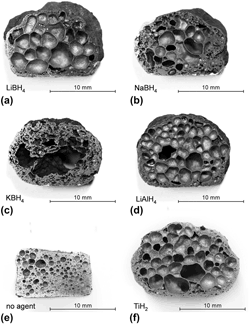Article contents
Suitability of various complex hydrides for foaming aluminum alloys
Published online by Cambridge University Press: 10 May 2013
Abstract

Some hydrides that could replace TiH2 as the hitherto most suitable blowing agent for foaming aluminum alloys were investigated. Hydrides taken from the group MBH4 (M = Li, Na, K) and LiAlH4 were selected since these have not been studied in the past although their decomposition characteristics appear to be suitable. Foamable precursors of alloy AlSi8Mg4 were manufactured by pressing blends of metal and blowing agent powders. Powders, precursors and precursor filings were studied by mass spectrometry to obtain the hydrogen desorption profile. Foaming experiments were conducted with simultaneous x-ray radiographic monitoring. Two Li-containing blowing agents were found to perform well and can be considered alternatives to TiH2.
- Type
- Invited Feature Paper
- Information
- Journal of Materials Research , Volume 28 , Issue 17: Focus Issue: Advances in the Synthesis, Characterization, and Properties of Bulk Porous Materials , 14 September 2013 , pp. 2436 - 2443
- Copyright
- Copyright © Materials Research Society 2013
References
REFERENCES
- 12
- Cited by




